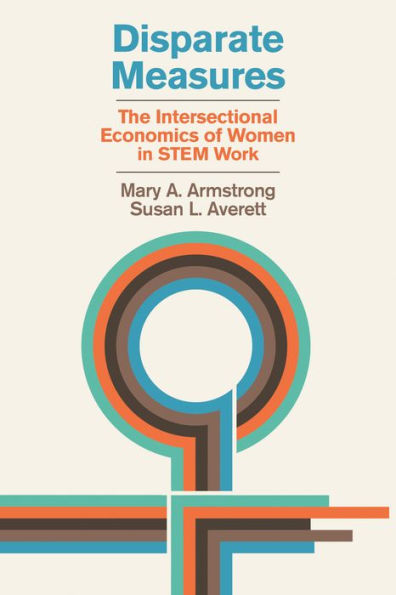
Disparate Measures: The Intersectional Economics of Women in STEM Work
376
Disparate Measures: The Intersectional Economics of Women in STEM Work
376Hardcover
-
PICK UP IN STORECheck Availability at Nearby Stores
Available within 2 business hours
Related collections and offers
Overview
Seen as part economic driver, part social remedy, STEM work is commonly understood to benefit both the US economy and people—particularly women—from underrepresented groups. But what do diverse women find when they work in US STEM occupations? What do STEM jobs really deliver—and for whom? In Disparate Measures, Mary Armstrong and Susan Averett challenge the conventional wisdom that a diverse US STEM workforce will bring about economic abundance for the women who participate in it. Combining intersectionality theory and critical data theory with a feminist economic analysis, the authors explore how different groups of diverse women truly fare in US STEM professions.
Disparate Measures is centered on eight unique, in-depth case studies, each of which provides an intersectional economic analysis (a term coined by the authors) of diverse women working in STEM occupations. Four case studies prioritize women of color and examine the STEM participation and earnings of Black women, American Indian and Alaska Native women, Asian and Pacific Islander women, and Hispanic women/Latinas; four additional case studies illuminate intersections that are frequently neglected by the STEM inclusivity literature: foreign-born women, women with disabilities, Queer women, and mothers. What the authors find in their groundbreaking, detailed analysis is that the promises of STEM are only partly true: when compared to women not working in STEM, most women are indeed economically elevated by STEM occupations—yet when compared to white men in the same STEM occupations, women’s second-class status is usually reaffirmed. The authors conclude by offering seven “big-picture” recommendations for rethinking STEM equity, showing just how we can successfully confront the entrenched patterns of economic disadvantage faced by diverse women in STEM jobs.

Product Details
| ISBN-13: | 9780262048866 |
|---|---|
| Publisher: | MIT Press |
| Publication date: | 04/09/2024 |
| Pages: | 376 |
| Sales rank: | 547,299 |
| Product dimensions: | 6.13(w) x 9.25(h) x 1.13(d) |
About the Author
Susan L. Averett is Charles A. Dana Professor of Economics at Lafayette College.
Table of Contents
ContentsAcknowledgments ix
Introduction: True Lies—The Narratives of STEM Diversity 1
1 Intersectional Economic Analysis: Theory and Praxis 17
2 Gender and STEM Work: A Particular Economy 33
3 Black Women in STEM 51
4 American Indian and Alaska Native Women in STEM 75
5 Asian and Pacific Islander Women in STEM 99
6 Hispanic Women/Latinas in STEM 129
7 Foreign-Born Women in STEM 155
8 Women with Disabilities in STEM 183
9 Lesbians, Bisexual Women, Trans Women, and Gender-Nonbinary Individuals in STEM 213
10 Mothers in STEM 249
11 Realities and Possibilities: Rethinking the Economics of Women in STEM Work 275
Appendix A: STEM Occupational Categories: American Community Survey and Current Population Survey 301
Appendix B: STEM-Related Occupational Categories: American Community Survey and Current Population Survey 303
Appendix C: STEM and STEM-Related Occupational Categories: National Health Interview Survey 305
References 307
Index 347
What People are Saying About This
“Disparate Measures not only questions the status quo. It’s also a call to action. It is a compelling must-read for anyone interested in understanding and addressing the obstacles faced by women in STEM.”
—Ebony McGee, Professor of Innovation and Inclusion in the STEM Ecosystem in the School of Education and the Department of Mental Health under the School of Public Health, Johns Hopkins University
“Disparate Measures offers sorely needed insights into the intersectional nature of STEM inequality and incisive criticism of STEM inclusion myths while promoting deep reflexivity about the social constructedness of social categories themselves. An absolute gamechanger.”
—Erin A. Cech, Associate Professor of Sociology, University of Michigan; author of The Trouble with Passion and Misconceiving Merit: Paradoxes of Excellence and Devotion in Academic Science and Engineering (with Mary Blair-Loy)
“This book is a must-read for any leader, scholar, or researcher who is serious about understanding why the economic case for diversity in STEM is not a simple one. From historical accounts to modern-day conceptualizations and theories of marginalization within STEM, this book captures the totality of what binds us and holds us back in diversifying STEM and, ultimately, what will free us.”
—Kelly Mack, Vice President for Undergraduate STEM Reform, American Association of Colleges and Universities
“Disparate Measures uses intersectional economic analysis to understand the many inequities facing women in STEM careers. Using a feminist perspective, it challenges conventional assumptions about diversity in STEM and neoliberal economic thought.”
—Donna K. Ginther, Roy A. Roberts & Regents Distinguished Professor of Economics and Director, Institute for Policy & Social Research, University of Kansas
